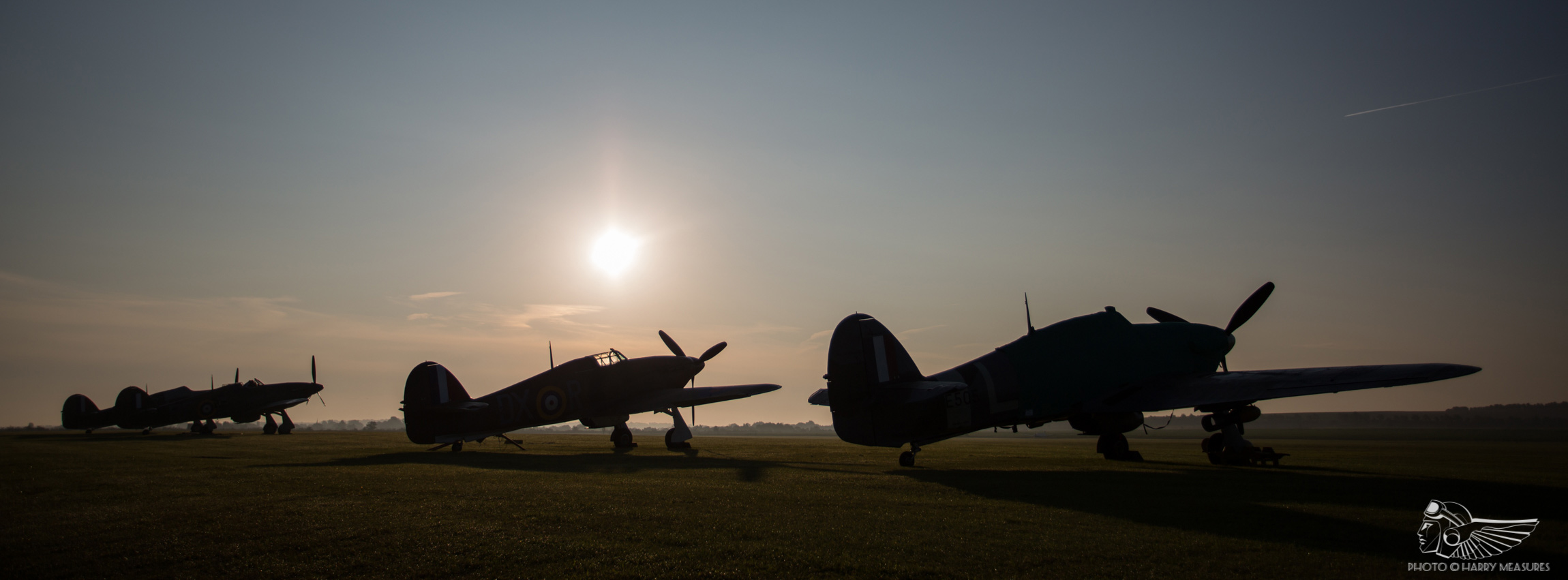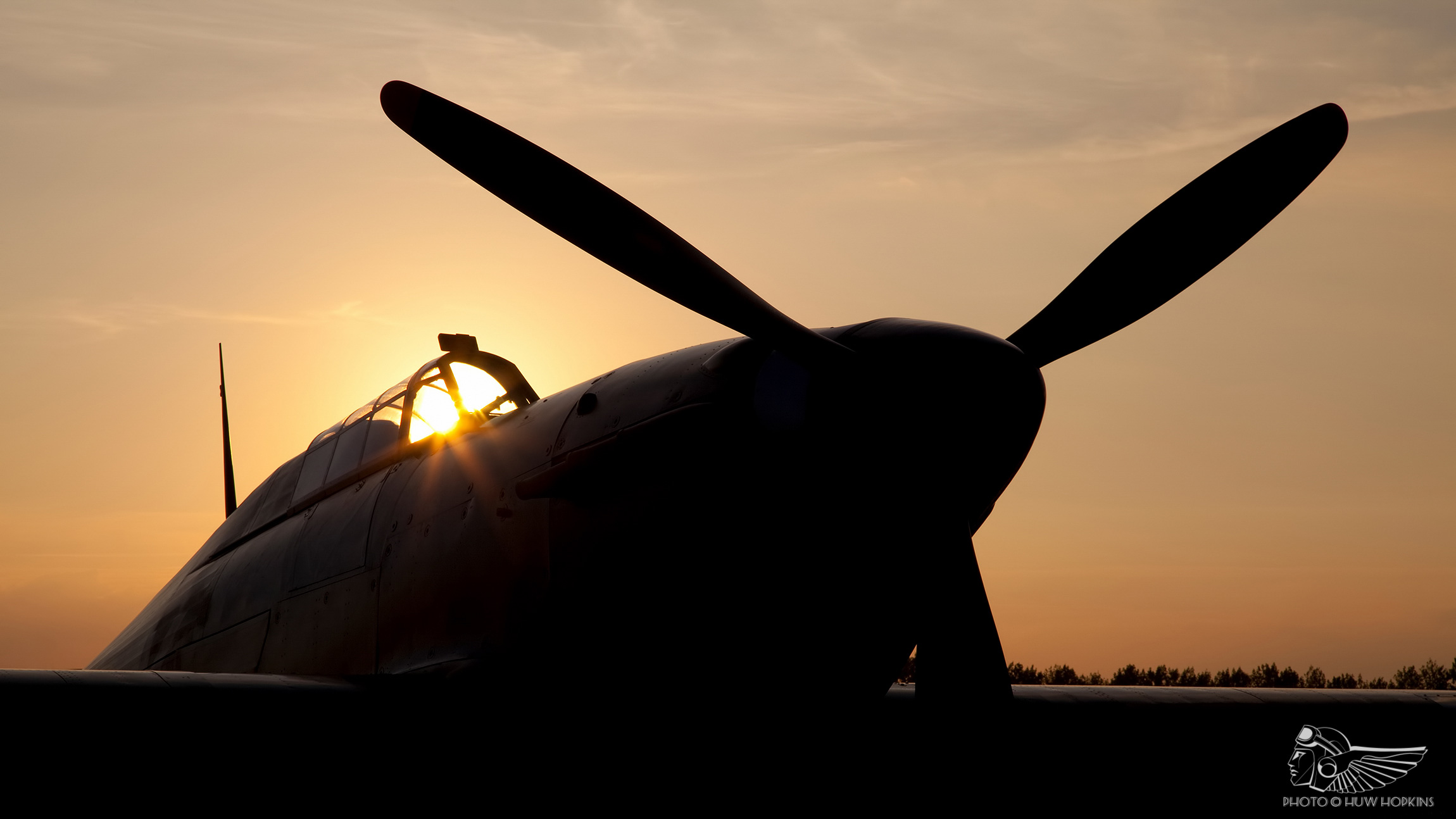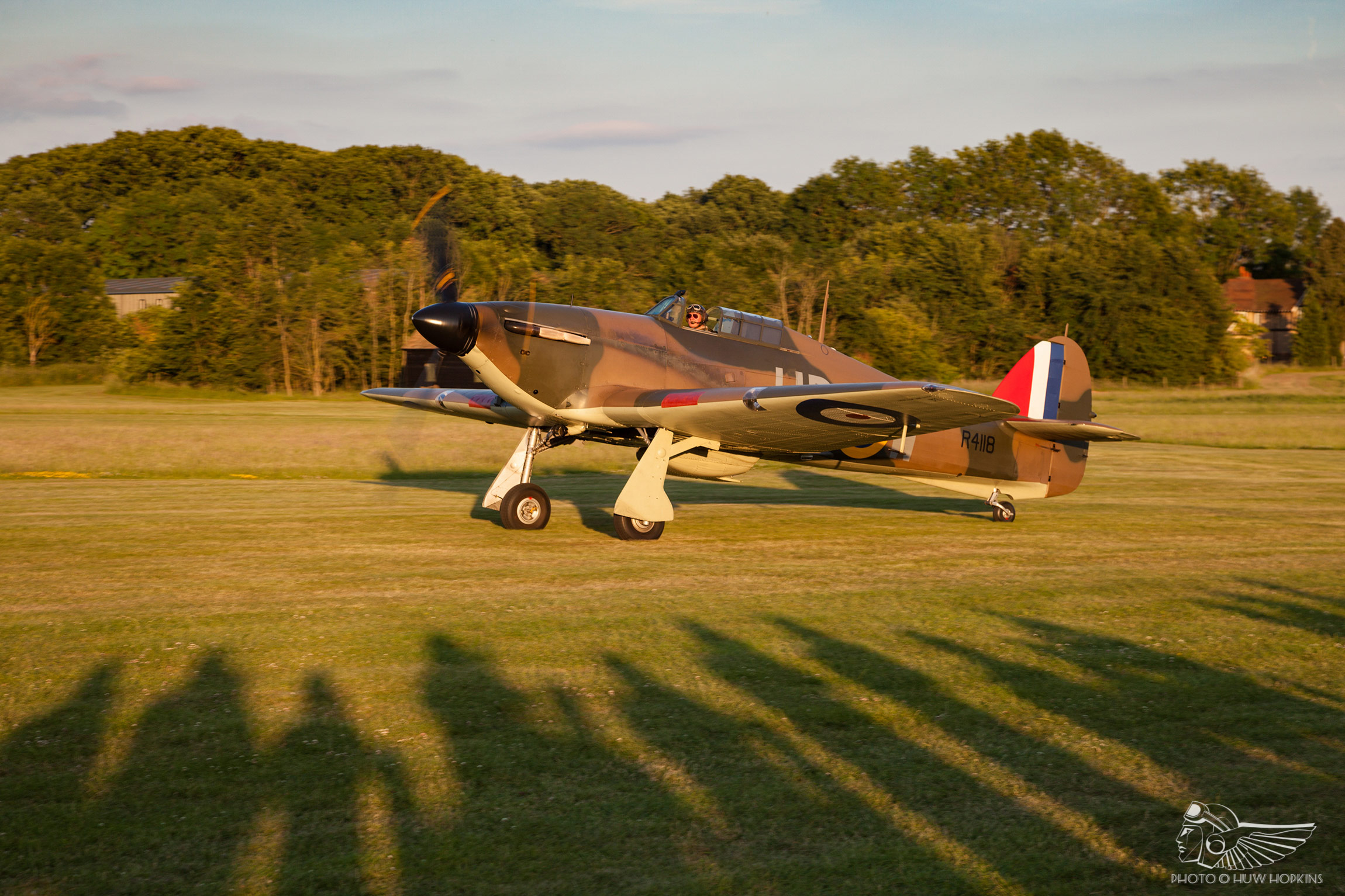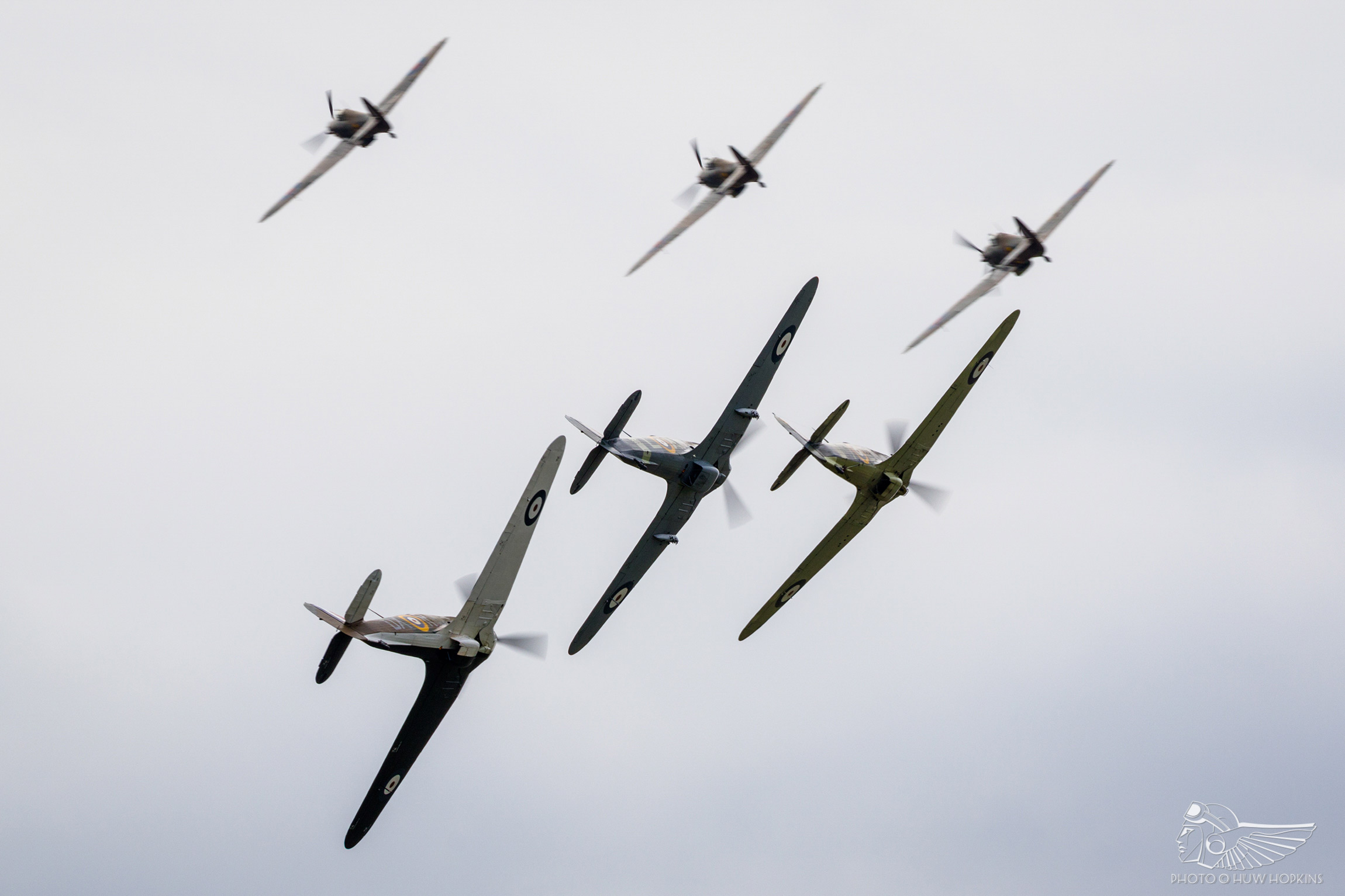2017 was truly the year of the Hawker Hurricane, with two restored examples returning to flight and significant gatherings of the type at major British airshows during the summer and autumn. The mustering of six aeroplanes at IWM Duxford’s Battle of Britain Air Show set the bar for Hurricane displays, and there has never been a better time to see multiple examples in the air.
An advanced design for its time, the Hawker Hurricane had the distinction of becoming the RAF’s first eight-gun monoplane fighter, and was the first RAF fighter capable of exceeding 300mph in a dive. Though Hurricanes formed the backbone of RAF Fighter Command during the Battle of France and Battle of Britain, it was the sleek, publicly-funded Supermarine Spitfire that captured the imagination and hearts of the British public. Whilst the two aeroplanes operated alongside one another on a similar playing field in 1940, the Spitfire would undergo repeated modifications throughout the war to keep it in contention with the ever-evolving Axis fighters. By contrast, Hawkers turned its attentions to developing new airframes in the form of the Typhoon and Tempest, resulting in the Hurricane being superseded and relocated to new theatres of war where it was pressed into service in other roles such as ground attack. Though it remained in front line service in every theatre, the Hurricane quietly faded from public view while the Spitfire went on to be idealised as Britain’s war-winning fighter.
The Hurricane’s design utilised the same construction techniques as its Hawker predecessors, and its production lines benefited accordingly with more than 14,500 manufactured; in the postwar preservation era, the metalwork and tubing skills essential to its manufacture were largely lost and aspects of the aircraft’s design which simplified Hurricane production in the 1940s conspired to make modern restorations more difficult and time consuming. Consequently, Hurricane restorations can require as many as 25,000 to 30,000 man hours and c. £2 million investment. These factors combine to make the Hurricane a complex aeroplane to return to flight in the present day, and it is thanks to dedicated owners and restorers that we get to see so many of these aeroplanes grace the skies.
There are currently a total of 15 airworthy Hurricanes worldwide, with the vast majority of these having returned to flight in the last 20 years. Much of the type’s resurgence is down to Hawker Restorations Ltd, the company founded in 1993 by the Alpine Fighter Collection’s Sir Tim Wallis and AJD Engineering’s Tony Ditheridge. The company’s small workshop in Suffolk, England has been completing Hurricane restorations at regular intervals since their first, P3351, flew in New Zealand in 2000. Working in partnership with Retrotec, the company which manufactured the Hurricane’s special rolled spar sections from high tensile steel strip sections, Hawker Restorations is responsible for returning the majority of the world’s airworthy population to the sky, and provided parts and assistance to the remainder. They are the cornerstone of the airworthy Hurricane population.
The number of airworthy Hurricanes in the UK plateaued for a number of years from the late-1990s to mid-2000s with around six airframes active, the backbone of which were the pair of Battle of Britain Memorial Flight machines, the Historic Aircraft Collection’s example (formerly owned by The Fighter Collection), Peter Vacher’s R4118 and the Shuttleworth Collection Sea Hurricane. Sales of AE977 to the USA (2001) and The Fighter Collection’s unique Mk.IV KZ321 to Canada (2006), as well as the sad loss of Spitfire Ltd’s Mk.XII G-HURR at Shoreham (2007), meant that it would be 2009 before more Hurricanes began joining the circuit, marking a sustained increase that has lasted to the present day. This was signalled by the first flight of the Hangar 11 Collection’s stunning Mk.IIb ‘Hurribomber’, marked as BE505 Pegs, in January 2009, the aircraft going on to become an established performer throughout the UK and Europe in the intervening years. Returning to the UK in 2013 was AE977, purchased by the Biggin Hill Heritage Hangar and relocated from the USA.
Mainland Europe has also done well in recent years, after a prolonged dearth of the type based on the continent. Following the closing down of Sir Tim Wallace’s Alpine Fighter Collection in New Zealand, P3351 was purchased by Jan Roozen in 2013 and shipped to Dijon, France – rather fitting given that the aircraft served in the Battle of France during 1940 before retreating to Britain. Eye-catching Rhodesian Air Force-schemed BW874 (marked as AG244) flew in the UK for a short while following completion at Phil Lawton’s Phoenix Aero Services Ltd in 2014, before it was sold to Karl Grimminger’s growing collection in southern Germany. Both of the aforementioned examples are seen in the UK from time to time, as well as at airshows and events around Europe. There is another prospect on the continent too, with the Belgium-based Vormezeele Collection purchasing the restoration project of Mk.IIb AM274 from the USA. This will be completed by FAST Aero at Brasschaat Airfield over the coming years, and is potentially destined to wear the rare Russian scheme in which it operated during the Second World War.
This concentration of around eight fliers in Europe has been conducive to some impressive gatherings of the type. With several large-scale events marking the 75th anniversary of the Battle of Britain, 2015 featured numerous events with multiple Hurricanes – four-ship displays had happened periodically in the past, but 2015 would top these in terms of numbers. The Royal International Air Tattoo’s massed formation had the accolade of featuring the largest number of Hurricanes in one piece of sky in recent history with five of the type amassed at RAF Fairford, and Biggin Hill’s ‘Hardest Day’ commemoration on 18 August saw five Hurricanes gathered on the historic airfield, though not all of them flew together in formation. Finally, Goodwood’s Battle of Britain Day Commemoration gathered six Hurricanes at the historic RAF Westhampnett aerodrome and although these were neither parked nor flew together as the separate elements departed the airfield at different intervals throughout the afternoon, it was significant for marking the largest Hurricane gathering in recent history. At that point Peter Vacher’s R4118 had been up for sale for a number of years and there was concern amongst the aviation enthusiast fraternity that the aircraft would end up being sold abroad. Thankfully, a new owner would be found in James Brown, who decided to base the Hurricane at Old Warden under the Hurricane Heritage banner. Here R4118 is on constant public view in the museum, as well as appearing at the Shuttleworth Collection’s regular airshows throughout the year – a really rather fitting home.
2017, though, has been the year in which the spotlight has well and truly been turned on the UK’s Hurricane population. Two first flights made the headlines, and more single and multiple Hurricane displays have been seen at airshows than ever before. In March, P3717 made its much-anticipated first flight from Turweston aerodrome and soon after moved to Old Warden to be operated by Bygone Engineering and hangared alongside Hurricane Heritage’s R4118 and the Shuttleworth Collection’s Sea Hurricane – the first time three Hurricanes had been based at the same aerodrome for many years. The Collection utilised the trio as a marquee act at their events this year with dynamic and engaging displays that have been high points of the airshow calendar. Dunkirk veteran P2902 also took to the skies just in time to appear at Duxford’s Flying Legends and complete one of the show’s star attractions: a five-ship of Hurricanes displaying together, joined initially by the Blenheim and a trio of Spitfire Mk.Is for what was an unrivalled early war formation. This spectacular sight was followed by a tail-chase of four Hurricanes whilst the débuting P2902 performed solo aerobatics overhead.
The pinnacle of the Hurricane resurgence thus far, however, took place at the IWM Duxford’s Battle of Britain Air Show in September, with a monumental six Hurricanes assembled to fly together in the opening segment of the flying programme, with a seventh flying in the subsequent slot courtesy of the Battle of Britain Memorial Flight. It’s worth noting that R4118 sat out this gathering, having been sidelined with engine issues. Despite this, it was the largest gathering and air display of airworthy Hurricanes since the 1951 filming of Angels One Five, when four British examples were joined by four from the Portuguese Air Force (operators of the type until 1954). The significance of this was emphasised to the crowds of 39,000 across the weekend by commentator Ben Dunnell. The sedate, wheeling tail-chase of six Hurricanes will live long in the memory and hopefully made an impact on the attending crowds, many of whom were families.
The renaissance is far from over, as another beautifully realised Hurricane is set to emerge from the Hawker Restorations workshops over this winter in the form of Battle of Britain veteran Mk.I V7497, meaning that by the time we reach the start of the 2018 airshow season the number of airworthy Hurricanes in the UK will have hit double figures. With just over 30 Spitfires currently airworthy in the country, the recent restorations bring the ratio of Hurricanes to Spitfires up to 1:3. Whilst Spitfires will always hold superior numbers, this is a marked change in the UK warbird landscape from years gone by.
Looking further ahead, once V7497 is complete the Hawker Restorations team will be focusing their attentions on a unique variant – a two-seat Hurricane. This will present the company with a unique design and construction challenge and once complete, L2005 (the donor identity) will be the only two-seat version of the type in existence. This Hurricane may well be in demand as it will surely be available in future for pleasure flights alongside the popular Fly in a Spitfire experiences, adding another element to the type’s representation in the historic scene – the opportunity to be able to fly in a Hurricane as a passenger, something quite impossible up until now!
The venerable Hurricane has never enjoyed such widespread and numerous representation at airshows. Who knows how many we may see in the air together in the future, with 2018 marking the RAF centenary and the 2020 Battle of Britain 80th anniversary commemorations on the horizon. As they gain a greater presence in a scene dominated by Spitfires, the aircraft may yet receive the wider acknowledgement and attention that it deserves, giving the Hurricane, its designers, engineers and pilots their rightful standing in history. As ‘The Few’ have now all but departed us and veterans of the latter Second World War theatres diminish, this is surely the lasting legacy that we owe them.
![]()







